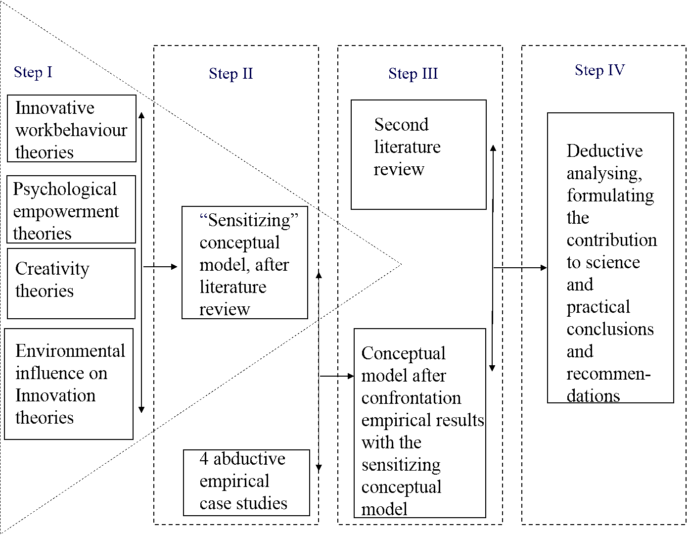As part of an external PhD study of four years at the University of Twente a brief article of the extended research plan is hereby provided. The research explores the influences of the work circumstances on innovative work behaviour by the operational employee. The article will zoom in on the research question, (sensitising) conceptual model, and methods. This document is the base for the case study at Philips Research in Eindhoven in the Netherlands.Relevance AssessmentIn our era of fast and global transitions businesses seek new innovative solutions to survive. The need for innovations calls for more ambidexterity in organisations. Simultaneously there is the exploitation of the business as usual. Fundamental changes are going on which needs new competences of the employees and managers (Raisch, Birkinshaw, Probst, & Tushman, 2009). At the same time in the environment of organisations individuals or small business are also bringing in disruptive innovations with quick changes in time and/or the new products or processes replacing the present ones (Christensen, 2009).
In contrast to this trend, both organisations and employees strive for stability (van Oss & van ’t Hek, 2008; van Hootegem, 1999; Vermeulen , 2011). To cope with this reality, scholars suggest utilising the power of individual innovations by employees (Kessels, 2015; Spreitzer, 1995 & 2007; Amabile, 1988 & 1999). The phenomenon of innovative work behaviour by individual employees has intensively been researched after Scott and Bruce (1994) published about this subject. Innovative work behaviour has several stages, In this research we are using the stages described by Dorenbosch, van Engen and Verhagen, 2005 as variables of innovative work behaviour.
These variables are: problem recognition, idea-generation, idea-promotion and idea-realization. The theoretical framework of the following research argues that creativity and psychological empowerment are expected to be important innovative personality features in showing innovative work behaviour (Amabile 1988 & 1999; Spreitzer 1995 & 2007).
The expectation is that because of the creative- and psychologically empowerment personality features, the employee will find a way to innovate even when the circumstances are not positively stimulating (de Jong, 2007; Nederveen-Pieterse, Knippenberg, Schippers, & Stam, 2009; Amabile 1988 & 1999; Spreitzer 1995 & 2007).
The literature study showed that transformational leadership, room for autonomy, and innovative influences from the external environment have positive effects on innovation. On the opposite side, transactional leadership do not have much room for autonomy, and no external innovative contacts can have a negative influence on innovative work behaviour (de Jong & den Hartog, 2010; Nederveen-Pieterse et al.,2009). But transactional leadership also is mentioned as a positive factor in the implementation phase of innovations (Anderson, Potočnik, & Zhou, 2014). The focus of this study, however, is not on these influences, but on the question of whether they have an impact on an employee with innovative work behaviour. Because we plan to explore the phenomenon of innovative work behaviour (in different stages), work circumstances and personality features in the context of a real life organisation where the boundaries of this context are not clear yet, we will do this research with a qualitative explorative case study method (Yin, 2018).
Research rationale
This study will explore the impact of personality features on the relation between work circumstances and innovative work behaviour of operational employees in its work unit.This knowledge helps to identify, understand, and facilitate employees with innovative work behaviour, which is can be useful in the contradiction between organisations and employees who strive for stability versus the need for innovations in an environment with fast and globally (disruptive) transitions.
Research questions
Main question:
What influence do innovative personality features (creativity and psychological empowerment) have on the relationships between the work circumstances (transformational or transactional leadership, room for autonomy, and external innovative contacts) and (stages of) innovative work behaviour of operational employees in their work units?
Sub questions:
What are the differences and similarities between the sensitising conceptual model and the empirical findings?
Do the work circumstances have the same effect on employees with much innovative personality features as it have on employees with less innovative personality features?
Research process
The figure below schematically shows the research process using the model of (Doorewaard, Kil, & Ven, 2015).
 Figure 1 research process
Figure 1 research process
Conceptual model for selecting employees to be interviewed
Sampling interviewees
The researcher found certain significant relations in the literature for the relation between the creative and psychologically personality features of a person and innovative work behaviour. The following model will be used as model to identify employees with innovative work behaviour in the case studies. The variables are used in a qualitative research with depth interviews. The interviews will be fully transcribed. Afterwards, using the Atlas software, will be analysed if the variables are recognizable.
 Figure 2 Model of innovative work behaviour (based on Amabile, 1988 & 1999; Spreitzer, 1995 & 2007; Dorenbosch, van Engen, & Verhagen, 2005).
Figure 2 Model of innovative work behaviour (based on Amabile, 1988 & 1999; Spreitzer, 1995 & 2007; Dorenbosch, van Engen, & Verhagen, 2005).
Sensitising conceptual model for the case study
The following sensitising conceptual model will be used in the case studies on the relationship between the independent, dependent and influencing variables. It is called a sensitizing model because the research is explorative. The researcher will have an open mind for new findings. New insights of the empirical phase will be confronted again afterwards with the literature which gives the possibility that this model iteratively will be changed. That’s why it is called a sensitising conceptual model.
 Figure 3 sensitising conceptual research model based on Amabile, 1988 & 1999; Spreitzer, 1995 & 2007; Dorenbosch et al., 2005 and the total literature review on influencing factors on innovative workbehaviour).
Figure 3 sensitising conceptual research model based on Amabile, 1988 & 1999; Spreitzer, 1995 & 2007; Dorenbosch et al., 2005 and the total literature review on influencing factors on innovative workbehaviour).
Case Study Methods
Within the tradition of an abductive way or researching we rely on a variation on the pure grounded method in which the researcher inductively tries to find the variables, after which a connection with the literature will be attempted to be found (Boeije, 2014).
By using the technique of Doorewaard, Kil, and Ven (2015), key concepts are broken down further into dimensions, topics, and indicators associated with the independent and dependent variables.
The research will be conducted with 4 case studies. In this research, the definition of a case study by (Swanborg, 2013) will be adopted as a guideline.
He explains a case study as research of a social and/or natural phenomenon in its natural environment during a certain period. Both the phenomenon and environment are part of a system. The researcher tries to find explanations for the phenomenon, starting with a broad research question in the beginning and not using very strict methods to remain open to surprising elements. Several data sources are used in a continuous exploration. The selection process consists of the following two steps:
Step one:
Two of the three of the possible influences are on an organisational level. These are the leadership and autonomy variables. The third influence can be found the individual employee’s level, which is the question if he or she is in contact with innovative influences outside of the company.
Firstly, the cases will be chosen on the circumstances level. To be sure that innovation is a daily activity in the cases, which is important for finding enough data, we looked for an organisation with have a high budget on research and development and which is big enough to find four cases with the right features. In a ranking list of the digital journal “Techniek and Wetenschap” we found that Philips had the highest research and development budget of the Dutch companies (including Philips lightening) in 2016 (Waardenburg, 2017). After connecting the Philips Chief Technology Officer we were invited by the Heads of a Division of Philips Research in Europe and the Business Excellence department of the CTO Organization, and they were very interested in our case study and willing to start the necessary internal procedures to execute the research and support us.
 Figure 4 case study quadrant
Figure 4 case study quadrant
The selection process of the cases will be done in de first place by an in-depth interview with managers/department heads. Hereby also the recommended questions a validated autonomy questionnaire, developed by Lumpkin , Cogliser, & Schneider (2009), will be used.
Input to formulate indicators for the depth interview to find the leadership form:
“TRANSFORMATIONAL LEADER
Charisma: Provides vision and sense of mission, instills pride, gains respect and trust.
Inspiration: Communicates high expectations, uses symbols to focus efforts, expresses important purposes in simple ways.
Intellectual Stimulation: Promotes intelligence, rationality, and careful problem solving.
Individualized Consideration: Gives personal attention, treats each employee individually, coaches, advises.
TRANSACTIONAL LEADER
Contingent Reward: Contracts exchange of rewards for effort, promises rewards for good performance, recognizes accomplishments.
Management by Exception (active): Watches and searches for deviations from rules and standards, takes corrective action.
Management by Exception (passive): Intervenes only if standards are not met.
Laissez-Faire: Abdicates responsibilities, avoids making decisions” (Bass, 1990, p. 22).
Also this interviews will be fully transcribed and afterwards analysed, using the Atlas software. The leaderschip features mentioned above will be used as variables which gives an indication of the sort of leadership. Lateron in step 2 also, as trangulation, will be checked in interviews with the employees if the managers shows the same kind of features on the working place.
Step 2
Step two will be to find employees with innovative work behaviour within the four cases (with the right autonomy and leadership features) and interviewing them about the influences of the circumstances on their behaviour. To exclude the possibility that the effects of the influences of circumstances are identical on employees with much and with less innovative work behaviour, interviews with employees with less innovative work behaviour will also be conducted. This is also necessary to find the answer on the second sub-question.
Since leadership is one of the influencing factors, the research targets are the employees. To secure internal validity, a form of triangulation will be applied. The work circumstances will be observed using an observation protocol. And there will be a desk research on relevant internal documents. The base for the observations will be the same items as in the interview protocol. But because it is explorative research the researcher will be open for new and other information. The number of interviews and the duration of the observation time will depend on the point at which saturation occurs. In other words, when no new information is obtained. It is expected that for about 10 interviews will be needed to reach this point (Doorewaard et al., 2015).
By selecting the cases in 4 different units in one organisation the reliability is secured. This because if the research will be held in 4 different organizations there will be the influence of this four different circumstances. Several carefully selected employees will be interviewed within the target group to match the following prerequisites: both male and female, long and short term employment, and younger and older employees. If an employee is mentioned by managers or colleagues as high innovative he or she will be part of the selection. Another way of recognize this persons are the number of patents they have in the years that they have worked on the department. This ensures that employees with expected innovative work behaviour will be a part of the research population.
The following definition and the conceptual model mentioned in figure 2 will give the criteria for the recognition of employees with innovative work behaviour:
“Innovative work behaviour is all employee behaviour aimed at the generation, introduction and/or application (within a role, group or organization) of ideas, processes, products or procedures, new and intended to benefit the relevant unit of adoption” (De Spiegelaere, van Guyes, & van Hootegem, 2014, p. 144). This definition will be translated in the interview protocol in indicators.
During the interviews the researcher will check to see if an employee is showing innovative work behaviour as defined in the theoretical framework, and if he/she has got the matching innovative personality features. Questions and observations on every variable of the sensitising conceptual model will be included. The interviews will be recorded with a voice recorder and fully transcribed and afterwards with the method of open, axial and selective coding be analysed (Boeije, 2014).
While composing this research proposal a test interview has been conducted which is a good example of what kind of findings are possible in this research. In this interview the researcher found that even though there was little room for autonomy in this case because of the Anglo-Saxon culture (the company was taken over by an big American investor), there was a leader who took a risk and gave his employees plenty of room for innovation. He believed in the innovative ideas of this employees. Meaning there was an interaction between two independent variables: leadership and room for autonomy. It led to a successful innovation which brought a big profit to the company.
The first part of the research can be seen as an abduction phase. The interviews will be open and explorative. After that the sensitising conceptual model will be restructured to make a conceptual model. This marks the start of the deduction phase. The empirically found variables will be used for a new systematic literature review including more search words in searching software as Google Scholar, using the same parameters mentioned listed above or the new found parameters. A combination of variables will be added to this, if preliminary research shows a relationship between them. The outcome of this review will be confronted with the conceptual model. Combined this will lead to the final conceptual model as a result of this research.
Bibliografie
Amabile, T. (1988). A model of creativity and innovation in organizations. Organizational Behavior, 123-167.
Amabile, T. (1999). How to kill creativity. In Harvard, Harvard Business Review on Breackthrough Thinking (pp. 1-28). Boston: harvard Business School Publishing .
Anderson, N., Potočnik, K., & Zhou, J. (2014). Innovation and creativity in organizations. Journal of Management, 1297– 1333.
Bass, B. (1990). From Transactional to Transformational Leadership: Learning to Share the Vision. Organizational Dynamics, 19-31.
Boeije, H. (2014). Analyseren in kwalitatief onderzoek. Den Haag: Bom Lemma.
Christensen, M. (2009). innovator’s prescription. Nes York: McGraw-Hill books.
de Jong, J. (2007). Individual innovation, the connection between leaderschip and employees innovative work behaviour. Zoetermeer: EIM.
de Jong, J., & den Hartog, D. (2010). Measuring innovative workbehaviour. Creativitiy and innovation management, 23-36.
De Spiegelaere, S., van Guyes, G., & van Hootegem, G. (2014). Innovatief werkgedrag als concept: definiëring en oriëntering. Gedrag en Organisatie, 139-156.
Doorewaard, H., Kil, A., & Ven, A. (2015). Praktijkgericht kwalitatief onderzoek. Den Haag: Boom Lemma uitgevers.
Dorenbosch, L., van Engen, L., & Verhagen, M. (2005). On-the-job Innovation: The Impact of Job Design and Human. On the job innovation, 129-141.
Kessels, J. (2015). Wat valt er aan talent strategisch te managen. In B. Overduin, & J. Hoogedoorn, Strategisch talent management (pp. 119-132). Alphen aan den Rijn: B+B vakmedianet.
Lumpkin , G., Cogliser, C., & Schneider , D. (2009). Understanding and Measuring Autonomy:An Entrepreneurial Orientation Perspective. Entrepreneurship Theory and Practice, 47-69.
Nederveen-Pieterse, A., Knippenberg, D., Schippers, M., & Stam, D. (2009). Transformational and transactional leadership and innovative behaviour, the moderating role of psychological empowerment. Journal of Organizational Behaviour, 609-623.
Raisch, S., Birkinshaw, J., Probst, G., & Tushman, M. (2009). Organizational Ambidexterity: Balancing Exloitation and Exploration for Sustained Performance. Organization Science, 685-695.
Scott, S., & Bruce, R. (1994). Determinants of Innovative Behaviour. Academie of management Journal, 580-607.
Spreitzer, G. (1995). Psychological empowerment in the workplace: dimensions, measurement and validation. Academy of management Journal, 1442-1465.
Spreitzer, G. (2007). Taking Stock: A review of more than twenty years of research on empowerment at work. In C. Cooper, & J. Barling, The Handbook of Organizational Behavior (pp. 54-72). Thousand Oaks CA: Sage Publication.
Swanborg, P. (2013). casestudies. Amsterdam: Boom Lemma Uitgevers.
van Hootegem, G. (1999). De draaglijke traagheid van management. leuven: Katholieke Universiteit Leuven Departement Sociologie.
van Oss, L., & van ’t Hek, J. (2008). Robuustheid en taaiheid. MO, 219-231.
Vermeulen , P. (2011). De verankerde organisatie. Den Haag: Boom Lemma uitgevers.
Waardenburg, I. (2017, mei 12). Techniek en wetenschap in perspectief. Retrieved from TW.nl: https://www.technischweekblad.nl/nieuws/philips-terug-aan-kop-in-r-d-top-30/item10339
Yin, K. (2018). case study research and applications. Thousand Oaks california: Sage productions.